
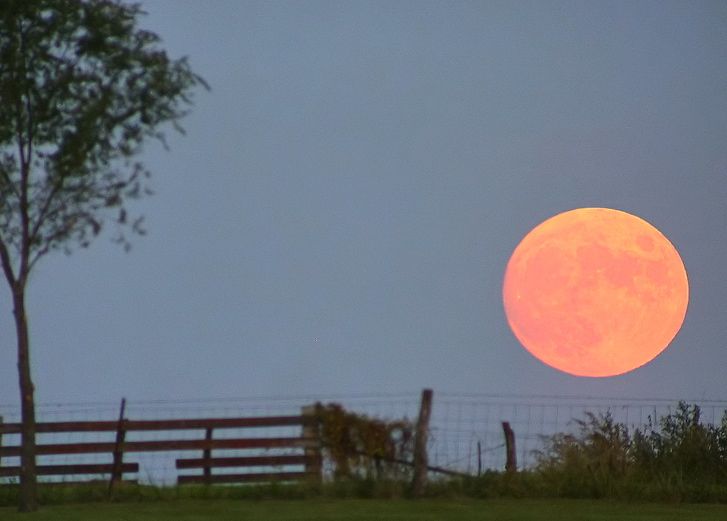
A Harvest Moon via Dan Bush of Missouri Skies.
Here in the Northern Hemisphere, we call the full moon closest to the autumn equinox the Harvest Moon. In 2020, the Northern Hemisphere autumn equinox came on September 22. Depending on where you live worldwide, the first of two October 2020 full moons will fall on October 1 or 2, 2020. Thus, for the Northern Hemisphere, this upcoming full moon in early October – the full moon closest to our autumn equinox – is our Harvest Moon.
For the Southern Hemisphere, the Harvest Moon always comes in March or early April.
Harvest Moon is just a name. In some ways, it’s like any other full moon name. But these autumn full moons do have special characteristics, related to the time of moonrise. Nature is particularly cooperative in giving us full-looking moons near the horizon after sunset, for several evenings in a row, around the time of the Harvest Moon.
What’s more, in 2020, the Harvest Moon will be near a fiery red object in our night sky. People around the world will be looking at the moon and wondering:
What star is that?!
It’s not a star. It’s the red planet Mars, now nearly at its best for this two-year period. See the chart below:
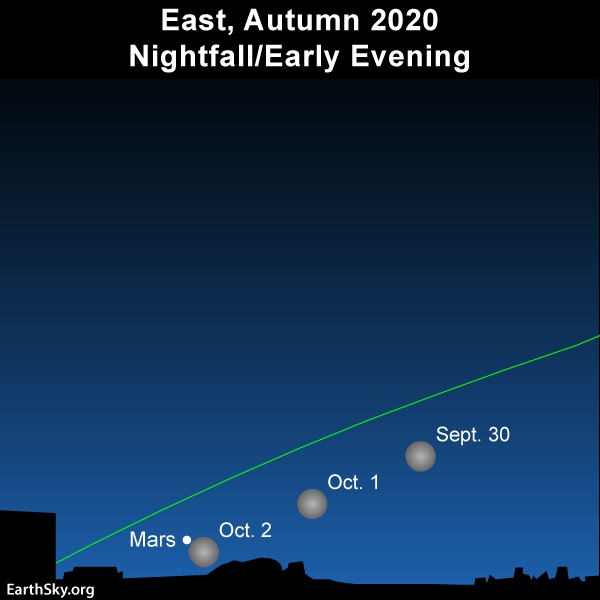
In late September and early October 2020, the Northern Hemisphere’s Harvest Moon shines in the vicinity of the brilliant red planet Mars. Mars is super bright now! Read more.
What is a Harvest Moon? On average, the moon rises about 50 minutes later each day. But when a full moon happens close to an autumn equinox, the moon rises closer to the time of sunset. For mid-temperate latitudes, it rises only about 25 to 30 minutes later daily for several days before and after the full Harvest moon.
For very high northern latitudes, there’s even less time between successive moonrises.
The difference between 50 minutes and 30 minutes might not seem like much. But it means that, in the nights after a full Harvest Moon, you’ll see the moon ascending in the east relatively soon after sunset. The moon will rise during or near twilight on these nights, making it seem as if there are several full moons – for a few nights in a row – around the time of the Harvest Moon.
Why does this happen? Check out the illustrations below:
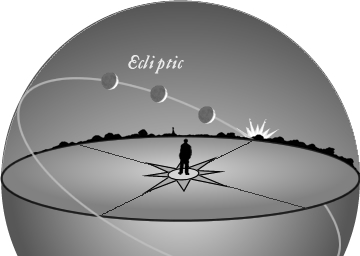
In autumn, the ecliptic – marking the moon’s approximate path across our sky – makes a narrow angle with the evening horizon. Image via classicalastronomy.com.

The narrow angle of the ecliptic means the moon rises noticeably farther north on the horizon from one night to the next. So there is no long period of darkness between sunset and moonrise. Image via classicalastronomy.com.
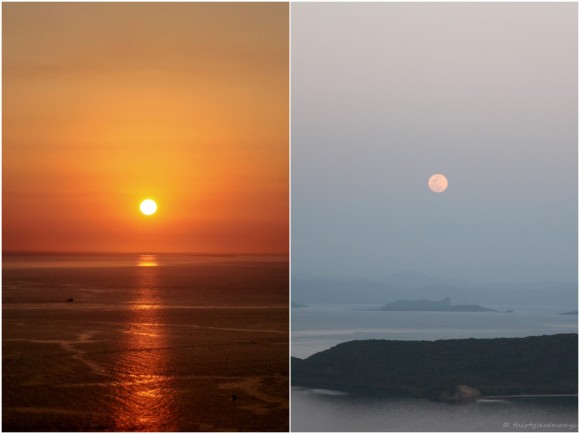
Harvest Moon sunset and moonrise – September 19, 2013 – as seen by EarthSky Facebook friend Andy Somers in Noumea, New Caledonia. One of the characteristics of the Harvest Moon is that it rises around the time of sunset for several evenings in a row.
Is the Harvest Moon bigger, or brighter or more colorful? Not necessarily.
Because the moon’s orbit around Earth isn’t a perfect circle, the Harvest Moon’s distance from Earth – and apparent size in our sky – is a bit different from year to year. In 2019, the Harvest Moon was actually a micro-moon or mini-moon: the most distant and smallest full moon of the year 2019. This year, in 2020, the Harvest Moon is the second-smallest full moon of 2020. But four years ago – September 28, 2015 – the Harvest Moon was the year’s closest and biggest supermoon.
Still, in any year, you might think the Harvest Moon looks bigger or brighter or more orange. That’s because the Harvest Moon has such a powerful mystique. Many people look for it shortly after sunset around the time of full moon. After sunset around the time of any full moon, the moon will always be near the horizon. It’ll just have risen. It’s the location of the moon near the horizon that causes the Harvest Moon – or any full moon – to look big and orange in color.
The orange color of a moon near the horizon is a true physical effect. It stems from the fact that – when you look toward the horizon – you’re looking through a greater thickness of Earth’s atmosphere than when you gaze up and overhead.
The bigger-than-usual size of a moon seen near the horizon is something else entirely. It’s a trick that your eyes are playing – an illusion – called the Moon Illusion. You can find many lengthy explanations of the Moon Illusion by doing an online search for those words.
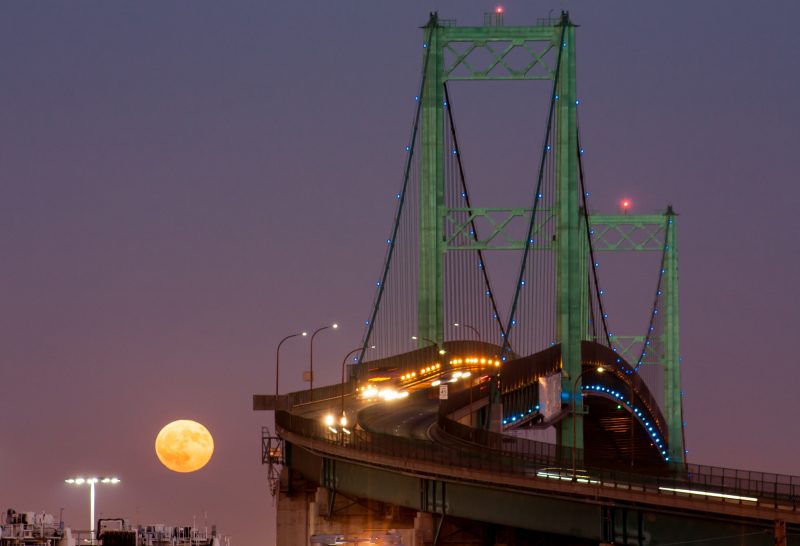
Jarred Donkersley caught this photo of 2016’s Harvest Moon at the Vincent Thomas Bridge in San Pedro, California.
When is the Harvest Moon in 2020? The exact time of the full Harvest Moon is October 1 at 21:05 Universal Time. At U.S. time zones, that translates to October 1, at 6:05 p.m. ADT, 5:05 p.m. EDT, 4:05 p.m. CDT, 3:05 p.m. MDT, 2:05 p.m. PDT, 1:05 p.m. Alaskan Time and 11:05 a.m. Hawaiian Time.
So watch for the Harvest Moon in late September and early October … or any of the nights around then.
By the way, more often than not, the September full moon is the Northern Hemisphere’s Harvest Moon. But if the full moon occurs in early October – as it did in 2017 and does in 2020 – the October full moon is that year’s Harvest Moon.
How did the Harvest Moon get its name? The shorter-than-usual lag time between moonrises around the full Harvest Moon means no long period of darkness between sunset and moonrise for days in succession.
In the days before tractor lights, the lamp of the Harvest Moon helped farmers to gather their crops, despite the diminishing daylight hours. As the sun’s light faded in the west, the moon would soon rise in the east to illuminate the fields throughout the night.
Who named the Harvest Moon? That name probably sprang to the lips of farmers throughout the Northern Hemisphere, on autumn evenings, as the Harvest Moon aided in bringing in the crops.
The name was popularized in the early 20th century by the song below.
Shine On Harvest Moon
By Nora Bayes and Jack Norworth (1903)
Shine on, shine on harvest moon
Up in the sky,
I ain’t had no lovin’
Since January, February, June or July
Snow time ain’t no time to stay
Outdoors and spoon,
So shine on, shine on harvest moon,
For me and my gal.
And don’t miss this more recent version of the song by Leon Redbone.
Bottom line: According to skylore, the closest full moon to the autumn equinox is the Harvest Moon. In 2020, the autumnal equinox for the Northern Hemisphere comes on September 22. So this hemisphere’s Harvest Moon comes on October 1.
Read more: What are the full moon names?
from EarthSky https://ift.tt/32EUQym


A Harvest Moon via Dan Bush of Missouri Skies.
Here in the Northern Hemisphere, we call the full moon closest to the autumn equinox the Harvest Moon. In 2020, the Northern Hemisphere autumn equinox came on September 22. Depending on where you live worldwide, the first of two October 2020 full moons will fall on October 1 or 2, 2020. Thus, for the Northern Hemisphere, this upcoming full moon in early October – the full moon closest to our autumn equinox – is our Harvest Moon.
For the Southern Hemisphere, the Harvest Moon always comes in March or early April.
Harvest Moon is just a name. In some ways, it’s like any other full moon name. But these autumn full moons do have special characteristics, related to the time of moonrise. Nature is particularly cooperative in giving us full-looking moons near the horizon after sunset, for several evenings in a row, around the time of the Harvest Moon.
What’s more, in 2020, the Harvest Moon will be near a fiery red object in our night sky. People around the world will be looking at the moon and wondering:
What star is that?!
It’s not a star. It’s the red planet Mars, now nearly at its best for this two-year period. See the chart below:

In late September and early October 2020, the Northern Hemisphere’s Harvest Moon shines in the vicinity of the brilliant red planet Mars. Mars is super bright now! Read more.
What is a Harvest Moon? On average, the moon rises about 50 minutes later each day. But when a full moon happens close to an autumn equinox, the moon rises closer to the time of sunset. For mid-temperate latitudes, it rises only about 25 to 30 minutes later daily for several days before and after the full Harvest moon.
For very high northern latitudes, there’s even less time between successive moonrises.
The difference between 50 minutes and 30 minutes might not seem like much. But it means that, in the nights after a full Harvest Moon, you’ll see the moon ascending in the east relatively soon after sunset. The moon will rise during or near twilight on these nights, making it seem as if there are several full moons – for a few nights in a row – around the time of the Harvest Moon.
Why does this happen? Check out the illustrations below:

In autumn, the ecliptic – marking the moon’s approximate path across our sky – makes a narrow angle with the evening horizon. Image via classicalastronomy.com.

The narrow angle of the ecliptic means the moon rises noticeably farther north on the horizon from one night to the next. So there is no long period of darkness between sunset and moonrise. Image via classicalastronomy.com.

Harvest Moon sunset and moonrise – September 19, 2013 – as seen by EarthSky Facebook friend Andy Somers in Noumea, New Caledonia. One of the characteristics of the Harvest Moon is that it rises around the time of sunset for several evenings in a row.
Is the Harvest Moon bigger, or brighter or more colorful? Not necessarily.
Because the moon’s orbit around Earth isn’t a perfect circle, the Harvest Moon’s distance from Earth – and apparent size in our sky – is a bit different from year to year. In 2019, the Harvest Moon was actually a micro-moon or mini-moon: the most distant and smallest full moon of the year 2019. This year, in 2020, the Harvest Moon is the second-smallest full moon of 2020. But four years ago – September 28, 2015 – the Harvest Moon was the year’s closest and biggest supermoon.
Still, in any year, you might think the Harvest Moon looks bigger or brighter or more orange. That’s because the Harvest Moon has such a powerful mystique. Many people look for it shortly after sunset around the time of full moon. After sunset around the time of any full moon, the moon will always be near the horizon. It’ll just have risen. It’s the location of the moon near the horizon that causes the Harvest Moon – or any full moon – to look big and orange in color.
The orange color of a moon near the horizon is a true physical effect. It stems from the fact that – when you look toward the horizon – you’re looking through a greater thickness of Earth’s atmosphere than when you gaze up and overhead.
The bigger-than-usual size of a moon seen near the horizon is something else entirely. It’s a trick that your eyes are playing – an illusion – called the Moon Illusion. You can find many lengthy explanations of the Moon Illusion by doing an online search for those words.

Jarred Donkersley caught this photo of 2016’s Harvest Moon at the Vincent Thomas Bridge in San Pedro, California.
When is the Harvest Moon in 2020? The exact time of the full Harvest Moon is October 1 at 21:05 Universal Time. At U.S. time zones, that translates to October 1, at 6:05 p.m. ADT, 5:05 p.m. EDT, 4:05 p.m. CDT, 3:05 p.m. MDT, 2:05 p.m. PDT, 1:05 p.m. Alaskan Time and 11:05 a.m. Hawaiian Time.
So watch for the Harvest Moon in late September and early October … or any of the nights around then.
By the way, more often than not, the September full moon is the Northern Hemisphere’s Harvest Moon. But if the full moon occurs in early October – as it did in 2017 and does in 2020 – the October full moon is that year’s Harvest Moon.
How did the Harvest Moon get its name? The shorter-than-usual lag time between moonrises around the full Harvest Moon means no long period of darkness between sunset and moonrise for days in succession.
In the days before tractor lights, the lamp of the Harvest Moon helped farmers to gather their crops, despite the diminishing daylight hours. As the sun’s light faded in the west, the moon would soon rise in the east to illuminate the fields throughout the night.
Who named the Harvest Moon? That name probably sprang to the lips of farmers throughout the Northern Hemisphere, on autumn evenings, as the Harvest Moon aided in bringing in the crops.
The name was popularized in the early 20th century by the song below.
Shine On Harvest Moon
By Nora Bayes and Jack Norworth (1903)
Shine on, shine on harvest moon
Up in the sky,
I ain’t had no lovin’
Since January, February, June or July
Snow time ain’t no time to stay
Outdoors and spoon,
So shine on, shine on harvest moon,
For me and my gal.
And don’t miss this more recent version of the song by Leon Redbone.
Bottom line: According to skylore, the closest full moon to the autumn equinox is the Harvest Moon. In 2020, the autumnal equinox for the Northern Hemisphere comes on September 22. So this hemisphere’s Harvest Moon comes on October 1.
Read more: What are the full moon names?
from EarthSky https://ift.tt/32EUQym


Aucun commentaire:
Enregistrer un commentaire